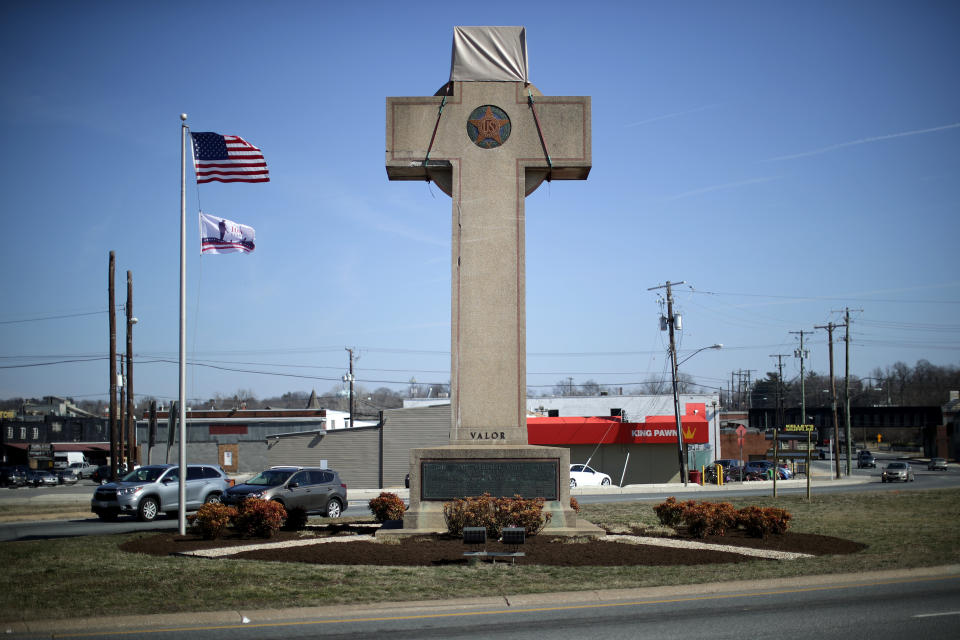Supreme Court Rules 40-Foot Cross On Public Land Does Not Violate Constitution
The Supreme Court ruled that a 40-foot World War I memorial in the shape of a Christian cross on Maryland public land does not violate the U.S. Constitution.
The justices held that the First Amendment’s establishment clause, which bars the government from unduly favoring one religion over another, does not require the removal of the monument from its location in a traffic median in the Washington, D.C., suburbs.
In a narrow and highly fragmented ruling, with an opinion written by Justice Samuel Alito, the court specified the monument’s role and “special significance in commemorating World War I.”
“Due in large part to the image of the simple wooden crosses that originally marked the graves of American soldiers killed in the war, the cross became a symbol of their sacrifice, and the design of the Bladensburg Cross must be understood in light of that background,” Alito wrote. “That the cross originated as a Christian symbol and retains that meaning in many contexts does not change the fact that the symbol took on an added secular meaning when used in World War I memorials.”
The ruling was highly unusual because while seven justices agreed that the cross does not violate the establishment clause, they disagreed over its interpretations and applications. Alito wrote the majority opinion, with Justices John Roberts, Stephen Breyer, Elena Kagan and Brett Kavanaugh joining only parts of Alito’s opinio. Breyer and Kavanaugh each wrote concurring opinions. Kagan joined Breyer’s opinion, and also wrote a shorter “opinion concurring in part.”
In addition, Justice Clarence Thomas wrote his own concurring opinion, yet joined another concurring opinion by Justice Neil Gorsuch.
Justices Ruth Bader Ginsburg and Sonia Sotomayor dissented.
Ginsburg argued that the cross could not be considered a secular symbol.
“As I see it, when a cross is displayed on public property, the government may be presumed to endorse its religious content,” she wrote. “The venue is surely associated with the State; the symbol and its meaning are just as surely associated exclusively with Christianity.”
The Peace Cross was dedicated in Bladensburg, Maryland, in 1925. It honors 49 soldiers from the area who were killed in World War I and features the names of the deceased, as well as a quote from President Woodrow Wilson, on its base.

The American Humanist Association, a nonprofit that promotes the separation of church and state, sent a letter to the Maryland-National Capital Park and Planning Commission in 2012 asking that the cross be replaced “with something more appropriate and universal.”
Two years later, the humanist association filed a federal lawsuit against the commission on behalf of three local residents, arguing that the cross’ presence on state-owned land violated the religious freedom protected under the First Amendment.
“To any passerby, a huge cross such as this can only be understood as endorsing Christianity,” the organization said at the time. “On public property, that violates the Establishment Clause. We can all support memorials to those who have fought for our country, but they cannot take the form of a massive religious symbol on government property.”
The state of Maryland and the American Legion, which built the cross, have long maintained that the memorial is secular in nature and aims only to honor veterans and not to promote religion.
In 2015, a federal judge ruled for the state and the American Legion. U.S. District Judge Deborah K. Chasanow found that the Peace Cross was “not a governmental endorsement of religion,” although she acknowledged that the so-called Latin cross “is undeniably a religious symbol.”
The U.S. Court of Appeals for the 4th Circuit later reversed that decision, and the Supreme Court agreed in the fall of 2018 to hear the case.
Over the years, the nation’s high court has failed to establish clear guidelines on when religious symbols may be displayed on public property and when they may not.
In Lemon v. Kurtzman, a 1971 case about public funding for private religious schools, the court laid out a broader three-pronged test for determining when a government law or practice violates the establishment clause. The “Lemon test” said that to be constitutional, the law or practice must have a secular purpose, neither advance nor inhibit religion as its principal effect, and not result in “excessive entanglement” of government and religion.
But in 2005, the Supreme Court opted not to use the Lemon test in determining the fate of another arguably religious display on public land. The decision in Van Orden v. Perry let a Ten Commandments monument remain standing on the Texas state Capitol grounds.
Read Thursday’s opinions below:
American Legion v. American Humanist Association by Anonymous LGS4Ky on Scribd
Love HuffPost? Become a founding member of HuffPost Plus today.
This article originally appeared on HuffPost.

